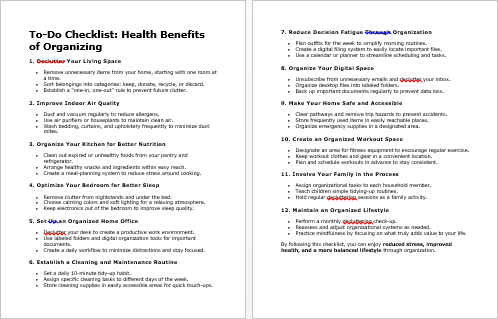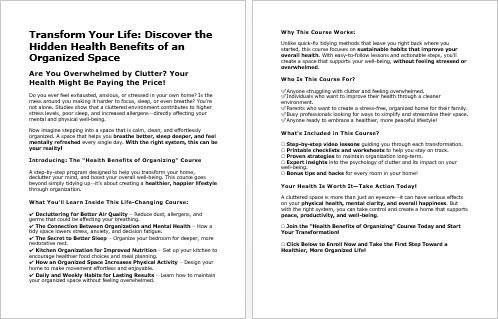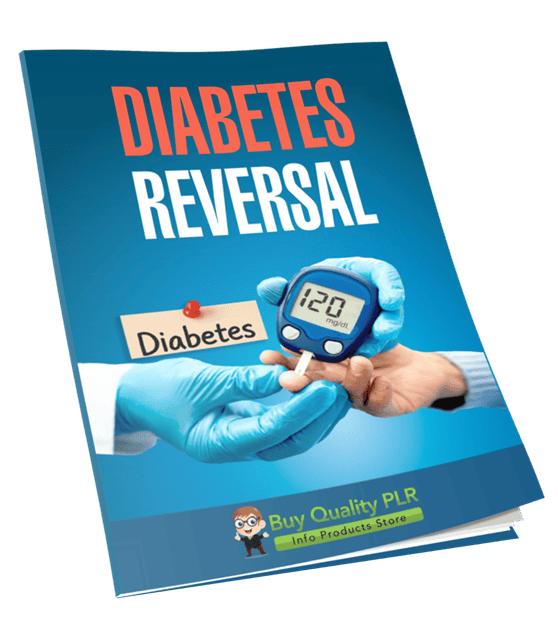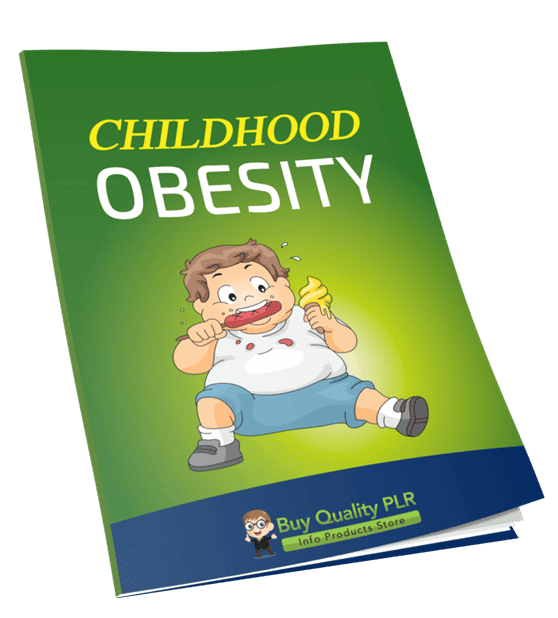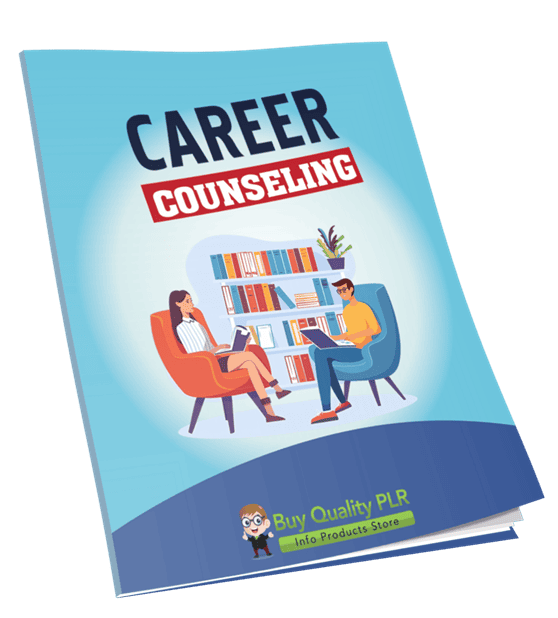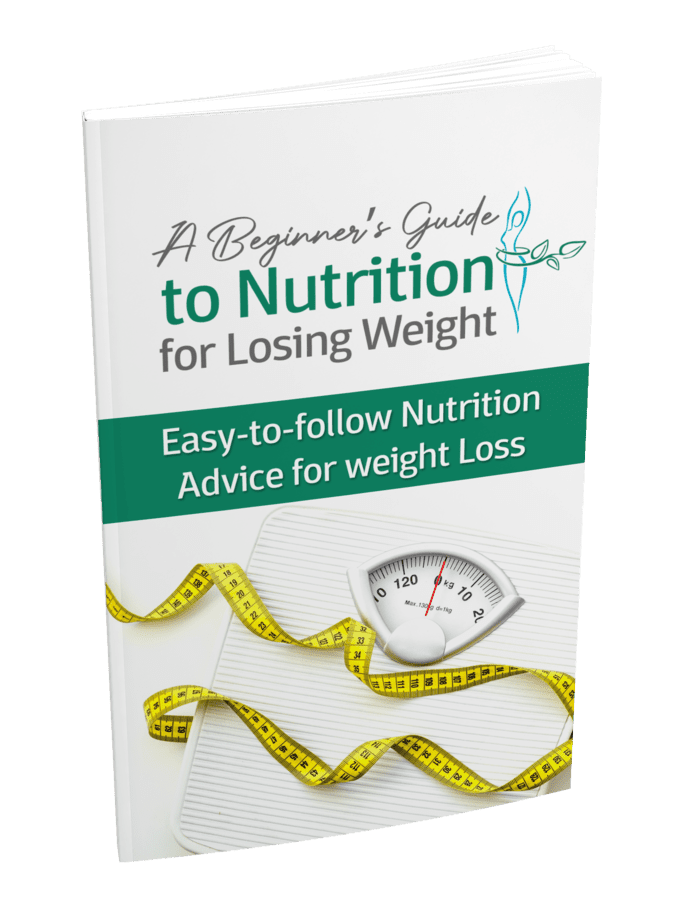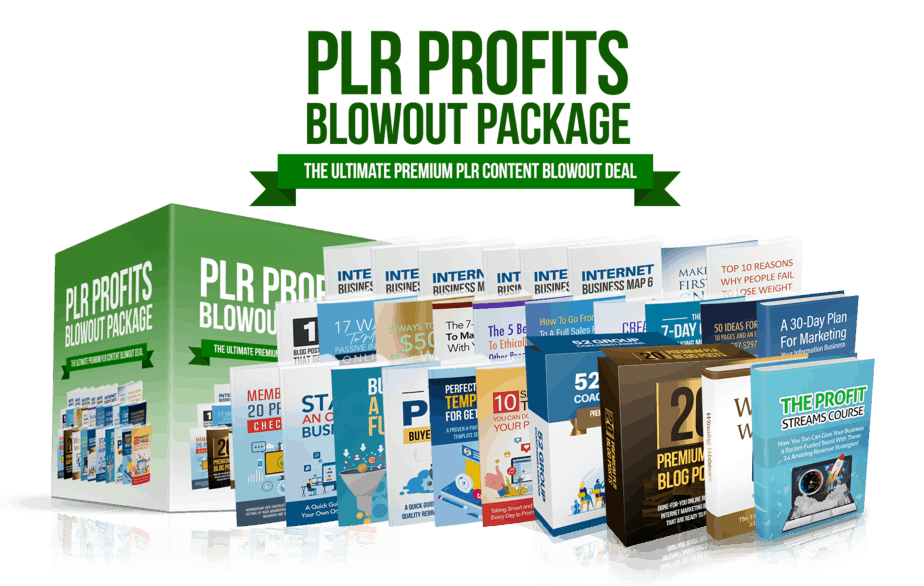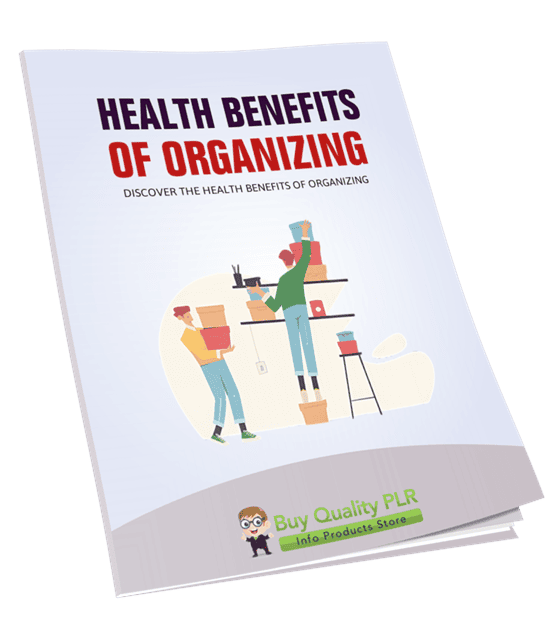
Health Benefits of Organizing PLR Course 22k Words
in Health PLR eBooks , Organization PLR , PLR Checklists , PLR eBooks , PLR eCourses , PLR List Building Reports , Premium PLR , Premium PLR eBooks , Premium PLR Reports , Premium White Label Brandable PLR Coaching Courses , Private Label Rights ProductsChoose Your Desired Option(s)
has been added to your cart!
have been added to your cart!
#organizingtips #declutteryourlife #healthyliving #plrcourse #wellnesscontent #mentalwellness #healthandproductivity #mindfulliving
Transform Your Space, Transform Your Life: Discover the Health Benefits of Organizing
Welcome to Health Benefits of Organizing – your ultimate guide to decluttering and organizing your life for improved mental and physical well-being. Whether you’re just beginning your organization journey or you’re looking for a structured approach to maintaining a clutter-free space, this course will help you transform your environment and enhance your overall health.
In this 20,041-word course, we’ll show you how organizing your home, work, and digital spaces can significantly impact your health. Get ready to reduce stress, improve focus, and even promote better sleep—all by simply decluttering and creating a well-organized space.
Presenting…
Health Benefits of Organizing PLR Course 22k Words
Course Overview
Did you know that a clutter-free space can dramatically improve your health? The Health Benefits of Organizing course explores the science behind organization and its positive effects on your mental and physical well-being. From reducing stress to improving productivity, this course covers the essential steps to help you take control of your environment and unlock a healthier lifestyle.
By the end of this course, you’ll not only understand the profound impact of an organized environment but also have practical strategies to implement in your daily life. Whether it’s learning how to declutter, improve your mental clarity, or boost your physical health, this course provides everything you need to create a space that supports your well-being.
Course Modules
Module 1: The Mind-Body Connection of Organizing
This module lays the groundwork for understanding how an organized environment impacts your health and how decluttering can reduce stress and increase productivity.
- Step 1: The Science Behind Clutter and Stress
Learn how clutter increases cortisol (the stress hormone), leading to feelings of overwhelm and anxiety. Discover how organizing your space can create a calming effect on your mind and body. - Step 2: How Organization Boosts Focus and Productivity
Understand how a tidy space improves your ability to focus and get things done. A well-ordered environment leads to less distraction and greater mental clarity. - Step 3: The Emotional Benefits of Letting Go
Holding onto physical clutter can create emotional baggage. Learn how decluttering your space can free your mind and elevate your mood. - Step 4: How Your Environment Affects Your Health
Explore the hidden health benefits of an organized home—better air quality, improved sleep, and even a boost in overall energy levels.
Module 2: Decluttering for a Healthier Life
This module covers practical, step-by-step strategies for clearing out clutter and setting up an organized, functional space.
- Step 1: The 5-Minute Decluttering Rule
Don’t feel overwhelmed! Use this quick and easy method to tackle clutter in just five minutes a day. - Step 2: Sorting with the “Keep, Donate, Discard” Method
Learn an easy system for deciding what to keep, donate, or discard. This method ensures that you only hold onto what’s truly important. - Step 3: Tackling Sentimental Items Without Stress
We all struggle with letting go of sentimental items. This section will help you preserve memories without cluttering your space. - Step 4: Creating a Maintenance Plan to Stay Organized
Prevent clutter from building up again by setting up daily and weekly habits to keep your space neat and tidy.
Module 3: Organizing for Mental Clarity
This module focuses on how organizing your space can enhance your mental well-being, reduce stress, and help you stay focused.
- Step 1: The Power of a Morning and Evening Routine
Start and end your day with an organized mindset. Establish routines that help you feel mentally clear and focused. - Step 2: Creating “Zones” in Your Home for Efficiency
Learn how to create distinct areas for specific activities—work, relaxation, meals, etc. This reduces distractions and promotes productivity. - Step 3: Organizing Your Digital Life for Less Stress
Don’t forget about your digital clutter! Organize your emails, documents, and files to reduce overwhelm and improve efficiency. - Step 4: The “One-Touch Rule” to Reduce Clutter Instantly
Learn how to deal with items right away and prevent the formation of clutter piles by following this simple rule.
Module 4: How Organizing Improves Physical Health
Organizing your space isn’t just good for your mind; it can also improve your physical health. This module covers how a clean and organized home leads to fewer health problems.
- Step 1: A Clean Space = Fewer Allergens and Germs
Understand how decluttering your home reduces dust, allergens, and germs, leading to better air quality and overall health. - Step 2: Meal Planning and Kitchen Organization for Better Nutrition
A clutter-free kitchen makes meal prep and healthy eating much easier. This step will teach you how to organize your kitchen for stress-free cooking. - Step 3: How an Organized Space Encourages Physical Activity
When your home is organized, it’s easier to stay active. We’ll show you how to design your space to encourage more movement throughout your day. - Step 4: The Link Between Organization and Better Sleep
A clutter-free bedroom leads to better sleep quality. Learn how organizing your sleep space can promote deeper, more restful sleep.
Module 5: Maintaining an Organized and Healthy Lifestyle
This module will help you build long-term habits to keep your space and mind clutter-free.
- Step 1: How to Make Organization a Daily Habit
Learn simple, 10-minute daily routines that will keep you organized and reduce the need for constant tidying up. - Step 2: Teaching Your Family to Stay Organized
Organizing is easier when everyone gets involved. Discover how to encourage your family to take responsibility for keeping the house tidy. - Step 3: The Mindset Shift: Embracing Minimalism Without Deprivation
Organizing isn’t about throwing everything away—it’s about keeping what truly adds value to your life. Learn how to embrace minimalism in a way that feels right for you. - Step 4: Using Organization to Reduce Decision Fatigue
An organized space helps you make better, quicker decisions. This final step will show you how organizing your home can reduce decision fatigue and improve your daily productivity.
Bonus Materials Included
Along with the core course content, you will also receive these valuable bonus materials:
- Health Benefits of Organizing – Checklist (414 words)
- Health Benefits of Organizing – FAQs (865 words)
- Health Benefits of Organizing – Salespage (507 words)
These bonus materials will make it easier for you to implement what you’ve learned and keep your space clutter-free.
How to Use and Profit from This Course
The Health Benefits of Organizing course isn’t just great for personal use—it’s also a fantastic business opportunity. Here are some ways to profit from this course:
- Sell the Course As-Is: Simply rebrand and sell the course with minimal changes to make it your own.
- Break It Into Smaller Reports: Divide the course into smaller, bite-sized reports and sell them for $10-$20 each.
- Bundle with Other Content: Bundle this course with other home improvement or wellness content and sell it as a larger product for $47-$97.
- Create an Online Course: Use the content to create a multi-week e-course and charge $297-$497 for access.
- Membership Site: Turn the course into a membership site where people pay for exclusive access to ongoing tips and content.
- Create a Physical Product: Print the course content as a physical guide or workbook and sell it for a premium price.
- Convert to Audio/Video: Turn the course into audio or video content and sell it on platforms like YouTube, Vimeo, or as a podcast series.
- Lead Magnet: Excerpt portions of the content and use it as lead magnets to grow your email list.
License Terms
Here’s what you can and cannot do with the Health Benefits of Organizing PLR Course:
What You Can Do:
- Sell the content as-is (with minor tweaks).
- Break the content into smaller reports and sell them individually.
- Bundle it with other content to create a larger product.
- Create and sell online courses, membership sites, or physical products.
- Convert the content into audio, video, or other formats.
- Excerpt portions for blog posts, lead magnets, or reports.
What You Cannot Do:
- Pass on PLR rights to your customers.
- Offer 100% affiliate commissions.
- Give away the entire content for free in its current state.
- Add it to existing customer orders without charging additional fees.
Get Started Today!
Take the first step towards a healthier, more organized life with the Health Benefits of Organizing PLR Course. This course provides everything you need to get started on your decluttering journey, improve your well-being, and boost your productivity.
Buy Now and start transforming your space and your life today! 🌿
has been added to your cart!
have been added to your cart!
Here A Sample of Health Benefits of Organizing PLR Course:
Did you know that organizing your space can improve your mental and physical health? In this course, you’ll learn how decluttering and organizing can help reduce stress, boost productivity, and even promote better sleep! Each module will walk you through practical steps to transform your environment and improve your well-being. Let’s get started!
Module 1: The Mind-Body Connection of Organizing
Understanding how a clutter-free space improves your mental and physical health
Step 1: The Science Behind Clutter and Stress
How Clutter Impacts Your Brain and Body
In today’s fast-paced world, clutter is more than just an inconvenience—it directly affects our mental and physical well-being. Scientific research has shown that cluttered environments can increase cortisol, the body’s primary stress hormone. Elevated cortisol levels are linked to anxiety, fatigue, trouble focusing, and even physical health issues such as high blood pressure and weakened immunity.
When we are surrounded by excessive objects, unfinished tasks, or disorganized spaces, our brains struggle to process information efficiently. This constant mental overload contributes to stress, leading to decision fatigue, reduced productivity, and emotional exhaustion.
By understanding how clutter influences our psychological and physiological states, we can take intentional steps to create a more organized, stress-free environment that supports a healthier mind and body.
The Psychological Impact of Clutter
1. Clutter Overstimulates the Brain
Your brain is designed to process a limited amount of information at any given time. A cluttered environment bombards your senses with excessive stimuli—visual distractions, unfinished tasks, and disordered items—all competing for your attention. This overstimulation forces the brain into a state of cognitive overload, making it harder to concentrate, prioritize, and make decisions.
🔹 Example: If your workspace is covered in papers, office supplies, and miscellaneous items, your brain constantly scans the clutter, trying to determine what is important. This reduces focus and increases stress.
Solution: Keeping your environment tidy allows the brain to relax, process information efficiently, and function optimally.
2. Clutter Triggers Stress and Anxiety
When a space is disorganized, it signals to the brain that there is unfinished work or unresolved tasks. This perceived lack of control can trigger anxiety and unease, as the mind associates clutter with things that need attention but have not been addressed.
🔹 Example: Studies from the Princeton Neuroscience Institute have shown that people who work in cluttered environments are more likely to experience frustration, distraction, and increased cortisol levels.
Solution: Organizing your surroundings creates a sense of order and control, which leads to a calmer and more relaxed state of mind.
3. Clutter Leads to Decision Fatigue
Every item in your space represents a choice—what to keep, where to store it, how to organize it. When you are surrounded by clutter, your brain must constantly make small, often unnecessary decisions, which depletes mental energy. This phenomenon is called decision fatigue, where the ability to make sound choices diminishes over time.
🔹 Example: If you have an overfilled closet, selecting an outfit each morning can feel overwhelming, leading to stress and wasted time.
Solution: Decluttering simplifies decision-making, conserves mental energy, and reduces daily stress.
The Physical Effects of Clutter
1. Clutter Increases Cortisol Levels
Studies have found that people who describe their homes as cluttered have higher cortisol levels throughout the day. Cortisol is the hormone responsible for the body’s “fight or flight” response, and when it remains elevated for extended periods, it can lead to:
✔️ Increased stress and anxiety
✔️ Difficulty sleeping
✔️ Lower immune function
✔️ Weight gain or unhealthy eating habits
🔹 Example: A study from UCLA’s Center on Everyday Lives and Families (CELF) found that women who described their homes as cluttered had higher cortisol levels than those with organized living spaces.
Solution: Reducing clutter helps regulate stress hormones, allowing for a more balanced and relaxed lifestyle.
2. Clutter Negatively Impacts Sleep Quality
A cluttered bedroom is often associated with poor sleep hygiene. Research indicates that people who sleep in messy rooms experience:
✔️ Difficulty falling asleep
✔️ Increased nighttime awakenings
✔️ Lower sleep quality
🔹 Example: The National Sleep Foundation found that individuals with clean and organized bedrooms reported better sleep compared to those with cluttered spaces.
Solution: Keeping the bedroom free from clutter promotes relaxation, which leads to deeper, more restorative sleep.
3. Clutter Can Lead to Physical Health Problems
Dust, mold, and allergens accumulate in cluttered spaces, leading to respiratory issues and allergic reactions. Additionally, cluttered environments increase the risk of tripping and falling, especially for children and elderly individuals.
🔹 Example: Homes with excessive clutter are more difficult to clean, leading to the buildup of dust mites and bacteria that can trigger asthma and allergies.
Solution: Regular decluttering and cleaning promote a healthier living space, reducing exposure to allergens and improving air quality.
The Benefits of an Organized Space
Now that we understand how clutter impacts our mental and physical well-being, let’s explore how an organized space can have the opposite effect—creating calm, focus, and overall better health.
1. Organization Reduces Stress and Overwhelm
A structured environment signals stability and control, helping to lower anxiety levels and increase a sense of well-being.
✔️ When you know where things belong, you eliminate the stress of searching for lost items.
✔️ A clean workspace improves concentration and efficiency, allowing for a more productive mindset.
2. A Decluttered Space Promotes Relaxation
When your surroundings are tidy, your brain interprets the environment as safe and peaceful, leading to a more relaxed state. This is particularly important in spaces like:
✔️ The bedroom, where relaxation is key for quality sleep.
✔️ The workspace, where clarity and focus are essential for productivity.
✔️ The kitchen, where organization leads to healthier eating habits and reduced stress around meal preparation.
3. An Organized Space Boosts Energy and Motivation
A clutter-free space fosters a positive mindset, higher motivation, and a sense of accomplishment. When you remove unnecessary distractions, your brain can focus on meaningful tasks, leading to increased creativity and problem-solving abilities.
✔️ A tidy home = a clear mind.
✔️ An organized workspace = better workflow and efficiency.
Practical Steps to Reduce Clutter and Stress
✅ Start Small – Begin with one area, such as your desk or nightstand, and gradually expand.
✅ Use the “One-Minute Rule” – If a task takes less than a minute (like putting away shoes or sorting mail), do it immediately.
✅ Adopt the “Keep, Donate, Discard” Method – Regularly assess items and remove what no longer serves a purpose.
✅ Create Organizational Systems – Use storage solutions that make daily routines seamless and efficient.
✅ Set a Daily Reset Routine – Spend 5–10 minutes each evening tidying up to maintain a clutter-free environment.
By applying these strategies, you can lower stress, improve mental clarity, and enhance your overall well-being. Organizing isn’t just about tidying up—it’s a powerful tool for reducing stress and creating a healthier, happier life.
Next, we’ll explore how an organized space boosts focus and productivity, so you can make the most of your time and energy.
Step 2: How Organization Boosts Focus and Productivity
Why an Organized Space Matters for Productivity
A well-organized space does more than just look appealing—it directly impacts your ability to focus, think clearly, and complete tasks efficiently. When your environment is cluttered, your brain has to work harder to filter out distractions, leading to mental fatigue, slower decision-making, and reduced productivity.
On the other hand, a tidy and structured workspace creates a sense of control, allowing you to stay focused and complete tasks faster with less stress and more efficiency. Research has shown that people who work in organized environments:
✔️ Make fewer errors and complete tasks more efficiently.
✔️ Experience less cognitive overload, allowing for better problem-solving and creativity.
✔️ Feel a greater sense of accomplishment and motivation, which leads to higher productivity levels.
In this step, we will explore the science behind organization and productivity and provide practical strategies to optimize your space for maximum focus.
The Link Between Organization and Focus
1. A Clutter-Free Space Reduces Mental Distractions
Every item in your environment competes for your attention, even if you’re not consciously aware of it. Clutter forces your brain to constantly scan and process unnecessary information, making it harder to concentrate on important tasks.
🔹 Example: Imagine working at a desk piled with papers, office supplies, and random objects. Your brain has to work harder to tune out distractions, making it more difficult to focus on what truly matters.
✔️ Solution: Keep your workspace minimal and purposeful. Remove unnecessary objects, store items in designated spaces, and maintain a clean surface to allow for uninterrupted focus.
2. Organization Helps Prioritize Tasks Effectively
Without structure, it’s easy to feel overwhelmed by an endless to-do list. An organized system allows you to:
✔️ Clearly define your priorities and break tasks into manageable steps.
✔️ Eliminate unnecessary tasks that waste time and energy.
✔️ Reduce procrastination by creating a sense of order and accountability.
🔹 Example: If you start your day without a plan, you may find yourself jumping between tasks without completing anything significant. A structured workspace, combined with a daily task list, helps you stay on track.
✔️ Solution: Use tools like planners, digital calendars, and to-do lists to map out your daily, weekly, and monthly tasks. Keeping track of priorities allows you to work more efficiently and feel more in control.
3. An Organized Space Supports a Clear Mind
When your environment is cluttered, your mind can feel just as chaotic. A clean and structured space fosters mental clarity, helping you:
✔️ Think more creatively.
✔️ Make decisions with confidence.
✔️ Feel less overwhelmed and more in control.
🔹 Example: A study from the Princeton Neuroscience Institute found that people who worked in tidy spaces had higher concentration levels and performed better on tasks compared to those in cluttered environments.
✔️ Solution: Start small—clear your desk, organize your digital files, and remove anything that does not serve a clear purpose. A decluttered space leads to a decluttered mind.
The Link Between Organization and Productivity
1. A Structured Workspace Saves Time
When everything has a designated place, you spend less time searching for lost items and more time focusing on work.
🔹 Example: If you frequently waste time looking for misplaced documents or supplies, your productivity suffers. Studies show that the average worker spends 4.3 hours per week looking for misplaced papers, which amounts to over 200 hours per year of lost productivity.
✔️ Solution: Implement simple organization systems such as labeled folders, storage bins, and digital filing systems to keep everything in order.
2. A Clean Environment Improves Work Efficiency
A structured space helps streamline workflows, making it easier to:
✔️ Complete tasks faster and with greater accuracy.
✔️ Reduce unnecessary back-and-forth caused by misplaced items.
✔️ Work in a stress-free, distraction-free environment.
🔹 Example: A study from Harvard Business Review found that employees working in organized spaces were 31% more productive and 23% less likely to experience burnout.
✔️ Solution: Create specific zones for different types of work. For example, designate an area for focused tasks, another for meetings or calls, and a separate space for storage. This prevents clutter from building up and ensures an efficient workflow.
3. Digital Organization Boosts Productivity
Physical clutter isn’t the only factor that affects focus—digital clutter can also slow you down.
✔️ A disorganized computer or inbox can lead to wasted time searching for files.
✔️ Excessive notifications can interrupt deep work sessions.
✔️ Too many browser tabs and open apps can create cognitive overload.
🔹 Example: If you have hundreds of unread emails, scattered files, and multiple open windows, it can feel overwhelming to start a task.
✔️ Solution:
✅ Organize your digital files into labeled folders.
✅ Use productivity apps like Trello, Notion, or Asana to manage tasks.
✅ Set specific times to check emails instead of responding to every notification immediately.
By maintaining both physical and digital organization, you create an environment that supports efficiency, focus, and mental clarity.
Practical Steps to Create a More Organized Space
✅ Step 1: Start with a Clean Slate
Begin by removing unnecessary items from your workspace. If you haven’t used something in the past six months, it’s likely not essential.
✅ Step 2: Create Designated Spaces
Assign specific places for different items—papers, supplies, digital files—so that everything has a home.
✅ Step 3: Implement Daily Organization Habits
Spend 5-10 minutes at the end of each day tidying up your space. This small habit prevents clutter from accumulating.
✅ Step 4: Use Productivity Tools
Leverage digital tools to keep track of your tasks, appointments, and important documents.
By making organization a daily habit, you will experience less stress, greater focus, and higher productivity levels.
Key Takeaways: Why Organization is Essential for Focus and Productivity
✔️ A clutter-free environment reduces distractions and allows your brain to focus on the task at hand.
✔️ Organized systems streamline tasks, minimize wasted time, and increase efficiency.
✔️ A structured workspace creates a sense of control, leading to higher motivation and reduced stress.
✔️ Digital organization is just as important as physical organization—keep your files, emails, and digital tools structured.
By applying these strategies, you can enhance your focus, complete tasks more efficiently, and create a stress-free work environment.
In the next step, we will explore how decluttering improves mental well-being and emotional balance, helping you create a healthier and happier life.
Step 3: The Emotional Benefits of Letting Go
Introduction: Why Letting Go is Essential for Emotional Well-being
Many people don’t realize that clutter isn’t just a physical issue—it’s deeply connected to emotions and mental health. The things we keep often hold sentimental value, represent past experiences, or reflect unfulfilled aspirations. But holding onto too many unnecessary items can create emotional weight, making it difficult to move forward.
Letting go of clutter is more than just a physical act—it’s a mental and emotional reset. Studies show that clearing out unnecessary items can:
✔️ Reduce stress and anxiety by creating a sense of order.
✔️ Improve mood and mental clarity by removing emotional triggers.
✔️ Increase confidence and control by fostering a fresh start.
In this step, we’ll explore why people struggle to let go, the psychological benefits of decluttering, and practical strategies to release emotional baggage through organization.
1. Understanding the Emotional Attachment to Clutter
Many of us hold onto items for emotional reasons rather than practical ones. Some common reasons include:
✔️ Sentimental Value: Items tied to memories (e.g., childhood toys, old letters, gifts from loved ones).
✔️ Guilt & Obligation: Keeping something because it was a gift, even if it no longer serves you.
✔️ Fear of Regret: Worrying that you might need something in the future, even if you haven’t used it in years.
✔️ Identity & Aspirations: Holding onto items that represent a past version of yourself or a dream you haven’t pursued (e.g., clothes that no longer fit, hobby supplies never used).
🔹 Example: You may have a closet full of clothes you haven’t worn in years but keep them because they remind you of a different time in your life. Or you might hold onto old books or paperwork, thinking they might be useful “someday.”
✔️ Solution: Recognizing that items don’t define you is the first step to emotional freedom. Decluttering allows you to create space for who you are now—not who you were in the past.
2. The Psychological Benefits of Letting Go
A. Decluttering Reduces Stress and Anxiety
A cluttered space often leads to a cluttered mind. When your environment is chaotic, your brain processes it as unfinished business, leading to feelings of stress and overwhelm.
🔹 Example: Studies from the UCLA Center on Everyday Lives of Families (CELF) found that people who live in cluttered homes have higher cortisol levels (the stress hormone), especially women.
✔️ Solution: By clearing out unnecessary items, you create mental space for peace and relaxation. A tidy home signals calmness to the brain, reducing daily stress.
B. Letting Go Improves Mood and Mental Clarity
When you release items that no longer serve you, it’s like removing emotional baggage. You feel lighter, more positive, and more in control.
🔹 Example: Many people report feeling instant relief and improved mood after a deep decluttering session, as if a weight has been lifted.
✔️ Solution: Try the “One-Year Rule”—if you haven’t used or worn an item in a year, it’s time to let it go. This helps eliminate excess and improves decision-making.
C. Decluttering Helps with Decision Fatigue
Too many choices can overwhelm the brain, leading to decision fatigue. The more clutter you have, the more decisions you must make daily (e.g., what to wear, where to find something, what to do with excess items).
🔹 Example: Steve Jobs and Mark Zuckerberg wore the same outfit daily to reduce decision fatigue, allowing them to focus on more important tasks.
✔️ Solution: Simplify your life by reducing excess items and creating a structured environment, allowing for better focus and less mental exhaustion.
D. Letting Go Fosters a Fresh Start
Decluttering is not just about getting rid of things—it’s about making space for new opportunities. Holding onto too much from the past can prevent you from moving forward.
🔹 Example: Letting go of old books, outdated paperwork, or items from a previous job can symbolize making room for new knowledge, career growth, and fresh experiences.
✔️ Solution: Ask yourself: Does this item support the future I want to create? If not, consider donating, recycling, or discarding it.
3. Practical Steps to Emotionally Declutter
Step 1: Identify Emotional Clutter
Before decluttering, take time to identify which items trigger stress, guilt, or emotional weight.
✔️ Look at your home and workspace—do certain items bring up negative emotions?
✔️ Do you keep things out of obligation, rather than because they bring you joy?
✔️ Are there items that make you feel stuck in the past?
🔹 Example: If a box of old letters from an ex-partner makes you sad, or if paperwork from an old job reminds you of stress, it might be time to let them go.
✔️ Solution: Keep only what truly adds value to your present life.
Step 2: Use the “Does This Serve Me?” Method
Ask yourself: Is this item adding to my life, or is it just taking up space?
✔️ If it’s useful and brings joy, keep it.
✔️ If it’s causing stress or taking up unnecessary space, consider letting it go.
🔹 Example: If you own five coffee mugs but only use two, keeping the extra three may be unnecessary clutter.
✔️ Solution: Be intentional about what you allow in your space.
Step 3: Try the “Box Test”
If you’re unsure about getting rid of something, put it in a box and store it out of sight.
✔️ If you don’t reach for it in three months, you probably don’t need it.
✔️ If you completely forget about it, it’s safe to let go.
🔹 Example: This works well for clothes, kitchen items, or sentimental objects you’re hesitant to part with.
✔️ Solution: Donate or recycle anything you haven’t needed within the time frame.
Step 4: Declutter with Gratitude
Letting go can be emotional, but gratitude helps shift your mindset.
✔️ Thank each item for its role in your life, then release it.
✔️ Recognize that memories stay with you, not the objects.
🔹 Example: When donating an old dress, acknowledge, “This dress served me well, but it’s time for someone else to enjoy it.”
✔️ Solution: Letting go with gratitude makes the process easier and more fulfilling.
4. The Long-Term Emotional Benefits of Decluttering
✔️ Less stress: A decluttered space leads to a decluttered mind.
✔️ More emotional freedom: You’re not weighed down by unnecessary attachments.
✔️ Greater joy and gratitude: You appreciate what you have and focus on the present.
✔️ A fresh start: Letting go makes space for new opportunities and personal growth.
By releasing what no longer serves you, you create an environment that supports mental and emotional well-being.
Conclusion: Embracing the Freedom of Letting Go
Letting go is a powerful act of self-care. It’s about freeing yourself from the emotional weight of clutter and creating space for peace, joy, and clarity.
✔️ Start small—choose one drawer, one shelf, or one category to declutter.
✔️ Focus on how you want to feel, not just what you want to remove.
✔️ Remember that your space should reflect your present and future, not just your past.
By taking control of your environment, you take control of your mental, emotional, and physical well-being.
In the next step, we’ll explore how an organized home can enhance relaxation and bring lasting happiness.
Step 4: How Your Environment Affects Your Health
Introduction: The Connection Between Your Space and Your Well-Being
Your surroundings have a direct impact on your physical and mental health. A cluttered, disorganized space can lead to increased stress, poor air quality, disrupted sleep, and even a weakened immune system. On the other hand, an organized and well-maintained environment can promote better breathing, deeper sleep, improved mental clarity, and overall well-being.
In this step, we’ll explore the hidden health benefits of a tidy and organized home, breaking it down into four key areas:
✔️ Air Quality and Respiratory Health – How clutter affects indoor air quality and breathing.
✔️ Sleep Quality and Relaxation – The link between organization and restful sleep.
✔️ Physical Health and Movement – How a clean space encourages an active lifestyle.
✔️ Mental Health and Stress Reduction – How an organized home promotes peace and emotional balance.
By the end of this section, you’ll understand how your environment influences your well-being and learn actionable steps to create a healthier space for yourself.
1. Air Quality and Respiratory Health
A. How Clutter and Dust Impact Breathing
A cluttered home traps dust, allergens, and pollutants, leading to poor indoor air quality. When surfaces are covered with excessive items, it becomes harder to clean properly, causing dust, pet dander, and mold to accumulate.
🔹 Example: Bookshelves filled with unnecessary items, piles of clothes, and forgotten corners of storage spaces collect dust, which can irritate your lungs and worsen allergies or asthma.
✔️ Solution:
- Declutter regularly to reduce dust-collecting surfaces.
- Use air purifiers to remove allergens and pollutants.
- Vacuum and dust frequently to improve indoor air quality.
B. The Role of Ventilation in a Healthy Home
Good air circulation is essential for fresh, clean air. When rooms are cluttered, airflow is restricted, leading to stale air and increased humidity, which encourages mold growth.
🔹 Example: A room filled with excessive furniture or boxes can block air vents, making it harder for fresh air to circulate.
✔️ Solution:
- Keep pathways clear for proper airflow.
- Open windows daily to allow fresh air in.
- Use dehumidifiers in damp areas to prevent mold and mildew.
By keeping your home organized and free of excess clutter, you improve air quality and respiratory health, making it easier to breathe and reducing allergy symptoms.
2. Sleep Quality and Relaxation
A. How Clutter Disrupts Sleep
A messy, disorganized bedroom can cause restlessness and poor sleep quality. Studies have shown that cluttered spaces create mental chaos, making it harder to unwind at the end of the day.
🔹 Example: The National Sleep Foundation found that people who sleep in a clean, organized bedroom are more likely to experience deeper, more restorative sleep.
✔️ Solution:
- Keep your bedside area clear of unnecessary items.
- Use soft, calming colors in your bedroom to promote relaxation.
- Limit electronic devices before bed to create a peaceful environment.
B. Creating a Sleep-Friendly Space
A tidy bedroom promotes better sleep hygiene, allowing your mind and body to relax more easily.
🔹 Example: A well-organized wardrobe means you don’t wake up to a pile of clothes on the chair, preventing stress first thing in the morning.
✔️ Solution:
- Invest in proper storage to keep your room organized.
- Make your bed daily to reinforce a sense of order.
- Use blackout curtains and maintain a cool temperature for optimal sleep.
By creating a calm and clutter-free sleep environment, you can improve the quality and duration of your sleep, leading to better overall health.
3. Physical Health and Movement
A. How Clutter Reduces Physical Activity
A cluttered home can make it harder to move freely and stay active. When items are scattered around, they create obstacles, making daily movement less fluid and increasing the risk of accidents.
🔹 Example: If your home gym space is full of unused furniture or if your kitchen is cluttered with unnecessary gadgets, you’re less likely to use these spaces for healthy activities.
✔️ Solution:
- Declutter walkways to prevent tripping hazards.
- Keep active spaces clear to encourage movement.
- Organize workout equipment so it’s easily accessible.
B. A Clean Kitchen Encourages Healthy Eating
An organized kitchen makes meal preparation easier, leading to healthier food choices. When your kitchen is cluttered, it’s harder to find fresh ingredients, leading to a reliance on processed or fast food.
🔹 Example: Studies show that people who cook in a clean, well-organized kitchen are more likely to make healthy meals instead of opting for takeout.
✔️ Solution:
- Keep countertops clear for easy meal prep.
- Arrange pantry items so healthy options are within reach.
- Store cookware properly to make cooking stress-free.
By removing clutter and organizing your space, you encourage a more active lifestyle and healthier eating habits, leading to improved physical health.
4. Mental Health and Stress Reduction
A. How a Clean Space Reduces Stress and Anxiety
Cluttered spaces overload your senses, making it harder for your brain to relax and focus. A disorganized environment constantly signals “unfinished tasks,” leading to chronic stress and anxiety.
🔹 Example: Studies have found that people who live in messy homes have higher cortisol levels, the hormone responsible for stress.
✔️ Solution:
- Declutter high-traffic areas (living room, kitchen, office) to create a calming environment.
- Adopt a minimalist approach—keep only what you truly need and use.
- Use organizational tools like bins, shelves, and labels to maintain order.
B. The Impact of a Peaceful Home on Mental Clarity
A clean, organized space promotes focus, motivation, and creativity. It allows your mind to process thoughts without the distraction of mess and disorder.
🔹 Example: Offices and workspaces that are well-organized increase productivity and reduce mental fatigue.
✔️ Solution:
- Declutter your workspace to boost concentration.
- Create designated areas for work, relaxation, and leisure.
- Incorporate calming elements like plants, soft lighting, and scents to enhance well-being.
By maintaining a well-organized environment, you create a space that nurtures mental clarity and emotional balance.
Conclusion: The Hidden Health Benefits of an Organized Home
Your environment has a powerful influence on your overall health. By keeping your space tidy and organized, you can:
✔️ Breathe easier with improved air quality.
✔️ Sleep better by creating a calm bedroom environment.
✔️ Move more freely and stay active in a clutter-free space.
✔️ Reduce stress and enhance mental clarity through an organized home.
Action Steps:
1️⃣ Choose one area of your home to declutter today.
2️⃣ Focus on improving air circulation by removing unnecessary items.
3️⃣ Create a calming bedtime routine with a tidy bedroom setup.
4️⃣ Organize your kitchen to encourage healthier eating habits.
By making small, consistent changes, you can transform your living space into a healthier, more peaceful environment.
In the next step, we’ll explore how to create sustainable organizing habits that last a lifetime!
We’re also giving these extra bonuses
Health Benefits of Organizing – Checklist
Health Benefits of Organizing – FAQs

Health Benefits of Organizing – Salespage Content
Package Details:
Word Count: 21 041 Words
Number of Pages: 110
Health Benefits of Organizing – Bonus Content
Checklist
Word Count: 414 words
FAQs
Word Count: 865 words
Salespage Content
Word Count: 507 words
Total Word Count: 22 827 Words
Your PLR License Terms
PERMISSIONS: What Can You Do With These Materials?
Sell the content basically as it is (with some minor tweaks to make it “yours”).
If you are going to claim copyright to anything created with this content, then you must substantially change at 75% of the content to distinguish yourself from other licensees.
Break up the content into small portions to sell as individual reports for $10-$20 each.
Bundle the content with other existing content to create larger products for $47-$97 each.
Setup your own membership site with the content and generate monthly residual payments!
Take the content and convert it into a multiple-week “eclass” that you charge $297-$497 to access!
Use the content to create a “physical” product that you sell for premium prices!
Convert it to audios, videos, membership site content and more.
Excerpt and / or edit portions of the content to give away for free as blog posts, reports, etc. to use as lead magnets, incentives and more!
Create your own original product from it, set it up at a site and “flip” the site for megabucks!
RESTRICTIONS: What Can’t You Do With These Materials?
To protect the value of these products, you may not pass on the rights to your customers. This means that your customers may not have PLR rights or reprint / resell rights passed on to them.
You may not pass on any kind of licensing (PLR, reprint / resell, etc.) to ANY offer created from ANY PORTION OF this content that would allow additional people to sell or give away any portion of the content contained in this package.
You may not offer 100% commission to affiliates selling your version / copy of this product. The maximum affiliate commission you may pay out for offers created that include parts of this content is 75%.
You are not permitted to give the complete materials away in their current state for free – they must be sold. They must be excerpted and / or edited to be given away, unless otherwise noted. Example: You ARE permitted to excerpt portions of content for blog posts, lead magnets, etc.
You may not add this content to any part of an existing customer order that would not require them to make an additional purchase. (IE You cannot add it to a package, membership site, etc. that customers have ALREADY paid for.)
Share Now!

